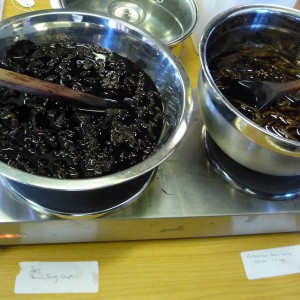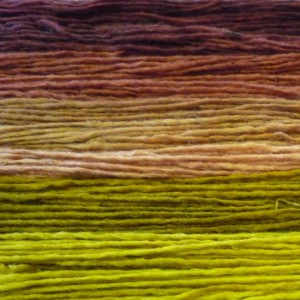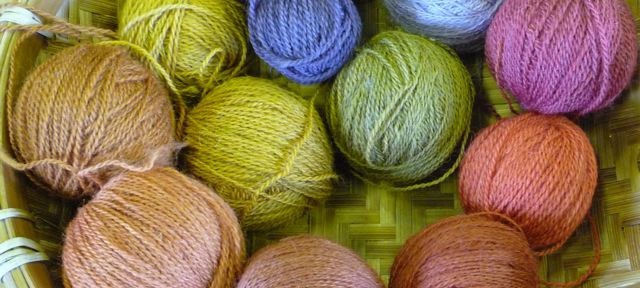
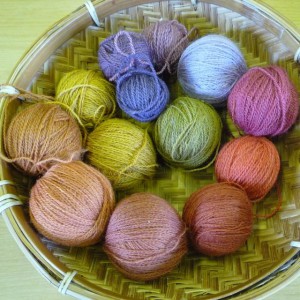
What do a few balls of wool and a day with a Guild of Weavers, Spinners and Dyers have to do with a Natural Talent apprenticeship? Read on, all will be revealed.
It’s been a while since my last post – sorry! – as I’ve been in a special kind of ecologist’s hibernation through the winter. However, spring is now well underway and I’ve pulled myself away from the microscopes and put the books to one side: it’s time to get blogging.
Gone for a while have been the long days hunting flowers and fungi. Instead, I’ve been enjoying other activities, from learning about environmental planning to making plans for project work in the forthcoming season. I’ve attended a variety of meetings, where I’ve been accumulating perspectives on what it is to be a working botanist/ conservationist/ land manager (delete as appropriate) in Scotland.
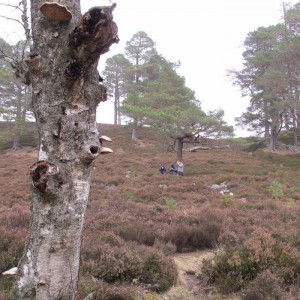
Bryologists underneath the big trees of Mar Lodge, in the heart of the Cairngorms. In the foreground there is evidence of Scot’s Pine regeneration – small trees are emerging from among the heather as a result of efforts to reduce deer numbers on the estate.
On a recent weekend I visited NTS properties Killiecrankie and Mar Lodge to look for bryophytes. These are the mosses and liverworts, or the so-called ‘lower’ plants. There are just under 1,000 species in Scotland, and the mountains host a rich and important flora. Regrettably, bryophytes haven’t had a mention on my blog yet as the fungi have kept me too busy. So, I’ve been spending a some time rekindling my love for the wee plants.
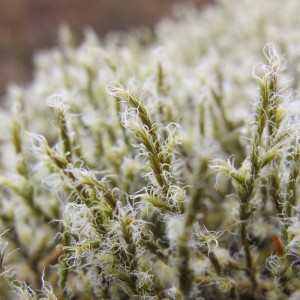
Racomitrium lanuginosum, Woolly Fringe-moss. A familiar sight even to non-botanists. It is the upland moss, where it can form extensive carpets.
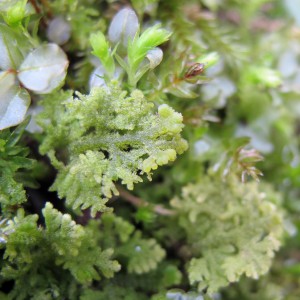
Trichocolea tomentella looks like a moss but is actually a lovely liverwort. Its leaves are so divided that it appears fluffy, and so the common name for the species is ‘Handsome Woollywort.’
I’ve spent much time buried in various texts and delving deep into academic journals. I had studied ecology at undergraduate and postgraduate level, and began my apprenticeship feeling that I’d at least a good theoretical knowledge of UK habitats, but how large my blind spot has been! I’ve realised how little I, and we in science and society, know about the fungal kingdom. I’ve learned that our understanding of fungi has hitherto been limited by the fact that many species straddle the micro- and macro worlds. In other words, they have been difficult to study: By only collecting fruit bodies we gain an incomplete picture of fungal presence and diversity. And, we can only guess based on proximity to nearby plants about host associations and the nature of ecological interactions below the soil surface. However, new advances in DNA-based molecular methods are enabling studies in fungal ecology at ever more reasonable cost and effort. This is an exciting prospect, and I continue as an apprentice with this in mind.
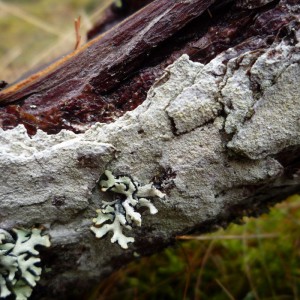
Appreciating fungi in all forms. These crusts on wood don’t look very exciting and are hard to identify in the field, but mycologist Liz Holden is their champion. These corticioids have some great features and discovering them under a microscope, she says, is like ‘unwrapping a Christmas present.’
Trisha Gow is an Edinburgh-based tapestry weaver and fungi dye artist who I’ve been lucky to spend a day with. According to Trisha, there is no historical or archaeological evidence of any cultures using fungi for dyes, and the craft has only been developing since the late 1960s. Together, we travelled into Fife to give a dyeing demonstration, and it was fascinating to see the range and depth of colours that can be gained from a few dried mushrooms. I’m told that blue is a rare colour to find in species that occur in the UK, but other countries are luckier. Interesting, too, is that you can’t guess what colour you might liberate based on the colour of a fruitbody, so don’t bother with a big, red Fly Agaric (Amanita muscaria) or try to get purple from an Amethyst Deceiver (Laccaria amethystina). On the day we took some previously dried collections and boiled them in water for almost an hour. Next, we added some skeins of pre-mordanted wool to the pans and continued to simmer for 30 minutes. The process is so simple that I’ve been having a go at home too. Any ideas for what I should knit with my wool?

